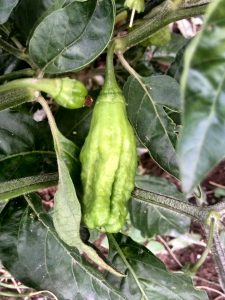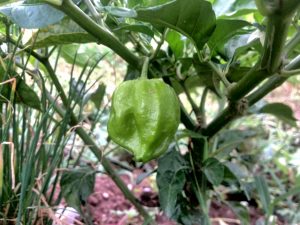Trinidad Moruga Scorpion grown from last year’s seeds
I collected seeds from my Moruga Scorpions last year. Seedlings were planted a bit later because of late spring, but summer soon brought much warmer weather than last season, with less rain and abundance of sun.
This year seedlings had serious issues with aphids and curling leaves. When the plants finally got established enough in the late July, first fruits emerged and I noticed they were not all the same as they were last year. I haven’t been growing any other chilli plants around it, so it came as a surprise to notice completely different fruits on one of the plants. 6 of the Trinidad Moruga Scorpion chilli plants seemed to grow chillies that were shaped the same as last year, only one of them had elongated fruits.


Closest paprika plants were growing around 20m away. There were no chillies around, except if one of the neighbours planted them, but again, they had to be quite far away. It will be interesting to see the size, color and shape of ripe fruits.
When I saw how different the plants were growing and especially the huge difference in size, shape and number of peppers, I thought that perhaps I received first generation of cross pollinated chillies. If their mother plant was indeed Trinidad Moruga Scorpion chilli, there might have been something else growing nearby and my only surviving seedling might have been a first generation hybrid. In second generation, many features of original plants that were cross-pollinated appear, which could be the cause of different growth pattern of my chilli seedlings.
If it’s in fact some kind of hybrid, strength and taste might also be different. I’ll update when it comes to that and later try to post about my findings and a little bit about genetics and hybridization in a new post. 🙂